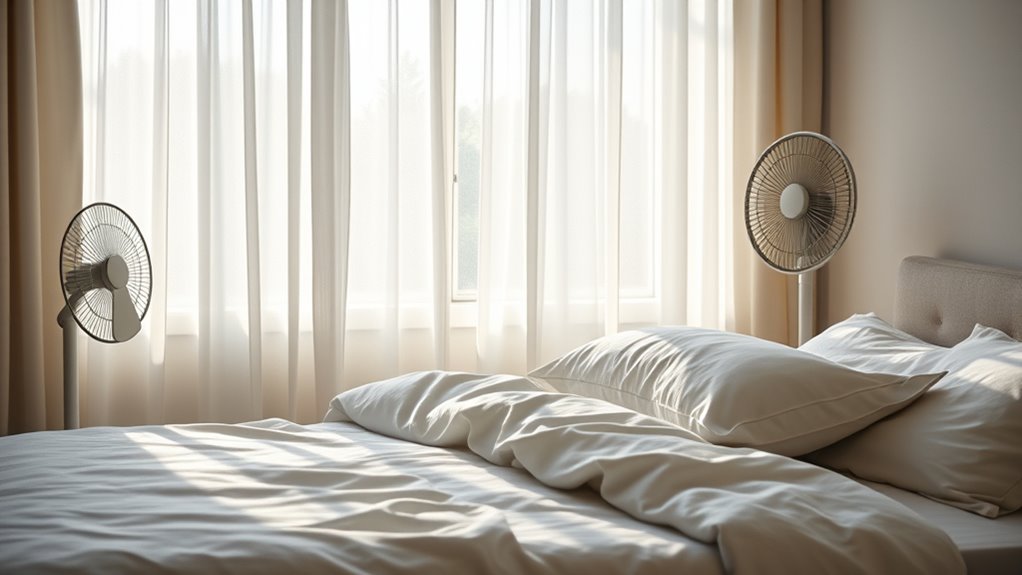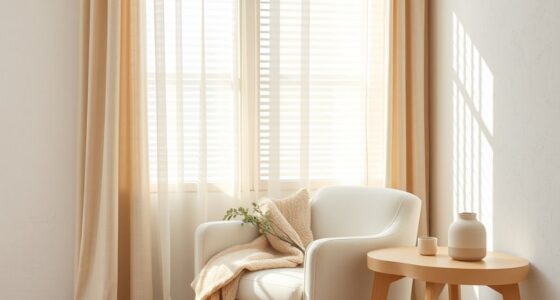To sleep cooler in summer, optimize your bedroom by opening windows in the evening and using fans with natural airflow. Choose breathable bedding like cotton or linen, and wear loose, lightweight sleepwear. Cool your body with splash showers or cold water on wrists and neck, and stay well-hydrated. Use reflective shades and blackout curtains to reduce heat gain. Incorporate smart cooling devices and create relaxing routines—keep exploring for more tips to beat the heat comfortably all night long.
Key Takeaways
- Maximize natural airflow by opening windows in the evening and sealing them during the day to keep your room cool.
- Use breathable bedding materials like cotton or linen and incorporate cooling accessories such as gel pillows for better comfort.
- Stay hydrated with cold water and take cool showers or splash water on wrists and neck before bed to lower body temperature.
- Utilize energy-efficient cooling devices like programmable fans or smart thermostats while blocking heat with reflective window shades.
- Establish a relaxing bedtime routine with dim lights, calming scents, and gentle stretching to help your body cool down naturally.
Optimize Your Bedroom Environment for Maximum Coolness
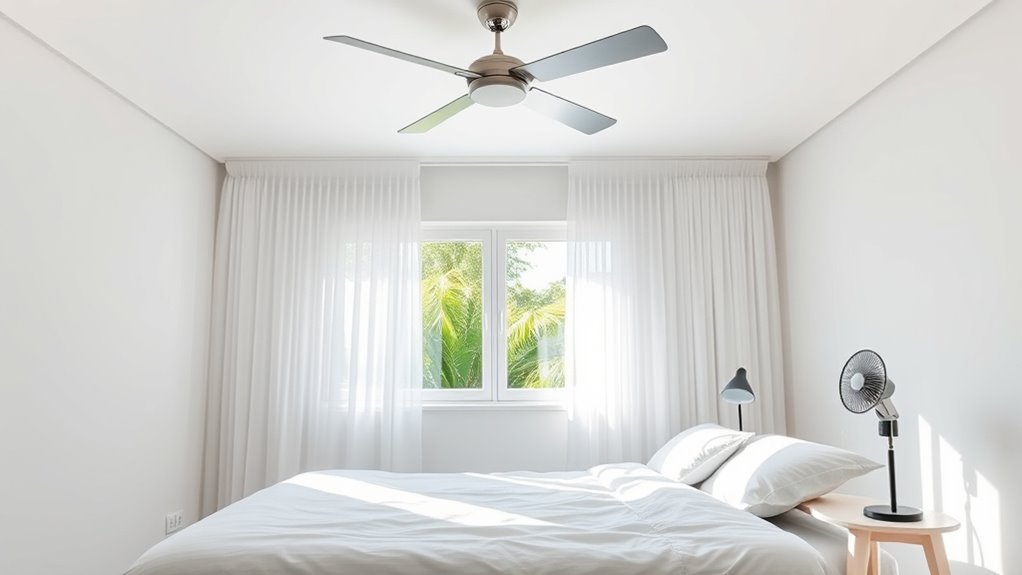
To keep your bedroom cooler, start by optimizing the environment around you. Good air circulation is key; open windows in the evening to let cooler air in and create a breeze. Use fans strategically to promote airflow without making the room drafty. Additionally, choose the right window treatments to block heat from the sun. Light-colored blinds or reflective shades can notably reduce heat gain during the day. Consider blackout curtains for nighttime, as they help insulate your room and keep it cooler longer. Combining these tactics helps you maintain a more comfortable temperature naturally, reducing your reliance on air conditioning. Proper ventilation and smart window treatments work together to create a cooler, more pleasant sleeping environment during hot summer nights.
Master the Art of Bedtime Cooling Techniques
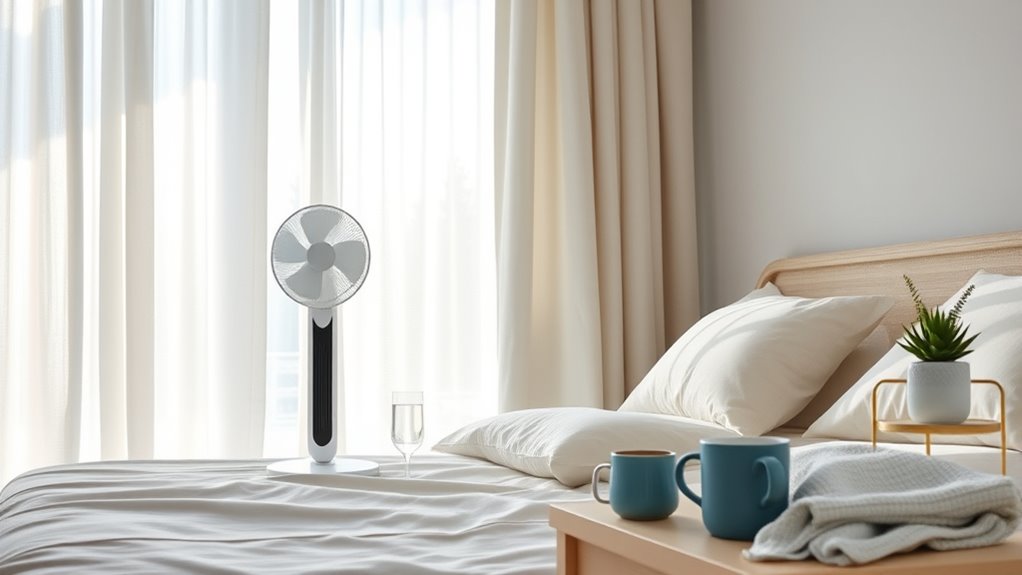
To stay cool at bedtime, choose breathable bedding materials that wick away heat and moisture. You should also optimize your bedroom temperature and incorporate cooling accessories like fans or cooling pillows. Mastering these techniques helps you sleep comfortably all summer long.
Use Breathable Bedding Materials
Choosing breathable bedding materials can considerably improve your sleep comfort during hot summer nights. Opt for fabrics like cotton, linen, or bamboo, which promote airflow and wick moisture away from your skin. Using cooling mattress pads made of breathable materials further enhances this effect, helping regulate your body temperature. To understand the benefits, see the table below:
| Material | Benefits | Best For |
|---|---|---|
| Cotton | Soft, breathable, moisture-wicking | Sensitive skin, all seasons |
| Linen | Cool, durable, moisture-absorbing | Hot sleepers |
| Bamboo | Hypoallergenic, lightweight | Sensitive skin, summer nights |
| Cooling Mattress Pad | Enhances airflow, cool surface | Hot sleepers, humid nights |
| Silk | Smooth, breathable, luxurious | Comfort-focused sleepers |
Switching to these materials keeps you cooler and more comfortable all night.
Optimize Bedroom Temperature
Enhancing your bedroom temperature can make a significant difference in achieving restful sleep during hot summer nights. Start by improving bedroom ventilation to promote airflow and reduce heat buildup. Open windows in the evening to let in cooler air, and consider using a fan to circulate it effectively. Window treatments play an essential role; opt for blackout curtains or reflective blinds to block out heat from the sun during the day. These treatments can keep your room cooler and prevent unwanted heat transfer. Additionally, ensure your windows are properly sealed to avoid warm air entering. By combining good ventilation with strategic window treatments, you create a more comfortable sleeping environment that naturally stays cooler without relying on energy-intensive solutions.
Incorporate Cooling Accessories
Have you considered using cooling accessories to beat the heat at bedtime? Personal cooling devices, like cooling pillows or gel-infused memory foam mattresses, can make a noticeable difference. Cooling accessories are designed to help regulate your body temperature and improve your sleep quality. For example, cooling pillows with breathable covers promote airflow and prevent heat buildup. You might also try personal cooling fans or wearable cooling wraps to keep your body temperature in check. These accessories are simple yet effective tools to enhance your sleep environment without major changes. Incorporating cooling accessories into your nightly routine gives you targeted, immediate relief from summer heat, making it easier to fall asleep faster and stay comfortable all night long.
Choose the Right Bedding and Sleepwear for Hot Nights

Choosing the right bedding and sleepwear can make a big difference on hot nights. Look for breathable fabrics and lightweight options that keep you cool without sacrificing comfort. Opting for hypoallergenic materials can also help you stay comfortable and sleep soundly.
Breathable Fabric Choices
During hot summer nights, selecting breathable fabrics can make a significant difference in your sleep quality. Look for bedding and sleepwear made from natural fibers like cotton, linen, or bamboo, as they allow better airflow and help keep you cool. Moisture-wicking fabrics are also a smart choice; they draw sweat away from your skin, preventing that sticky feeling and helping you stay dry and comfortable throughout the night. Avoid synthetic materials like polyester, which trap heat and moisture. Instead, opt for breathable fabrics that promote ventilation and wick away moisture. This simple switch can improve your sleep environment, reduce overheating, and help you wake up feeling more refreshed and rested.
Lightweight Sleepwear Options
Looking for sleepwear that keeps you cool on hot summer nights? Opt for lightweight sleepwear made from breathable pajamas that promote airflow and wick away moisture. Choose fabrics like cotton, linen, or bamboo, which are naturally breathable and help regulate your body temperature. Loose-fitting styles allow air to circulate around your skin, preventing overheating. Avoid heavy or tight pajamas, as they trap heat and can cause discomfort. Consider sleeveless or short-sleeved options for extra ventilation. The goal is to feel comfortable and cool without sacrificing softness or style. By selecting lightweight, breathable pajamas, you’ll enhance your sleep quality and wake up feeling refreshed, even during the most sweltering nights.
Hypoallergenic Bedding Materials
Opting for hypoallergenic bedding materials can make a significant difference in staying cool and comfortable on hot summer nights. Hypoallergenic bedding is designed to reduce allergens and irritants, helping you breathe easier and sleep better. Look for bedsheets and pillowcases made from allergen reducing fabrics like bamboo, cotton, or linen, which are breathable and moisture-wicking. These materials prevent heat buildup and promote airflow, keeping you cooler throughout the night. Avoid synthetic fabrics, as they trap heat and can cause sweating. Choosing the right hypoallergenic bedding not only minimizes allergy symptoms but also enhances comfort during warm weather. With the right allergen reducing fabrics, you create a healthier, cooler sleep environment that makes hot summer nights more bearable.
Use Natural Methods to Lower Your Body Temperature
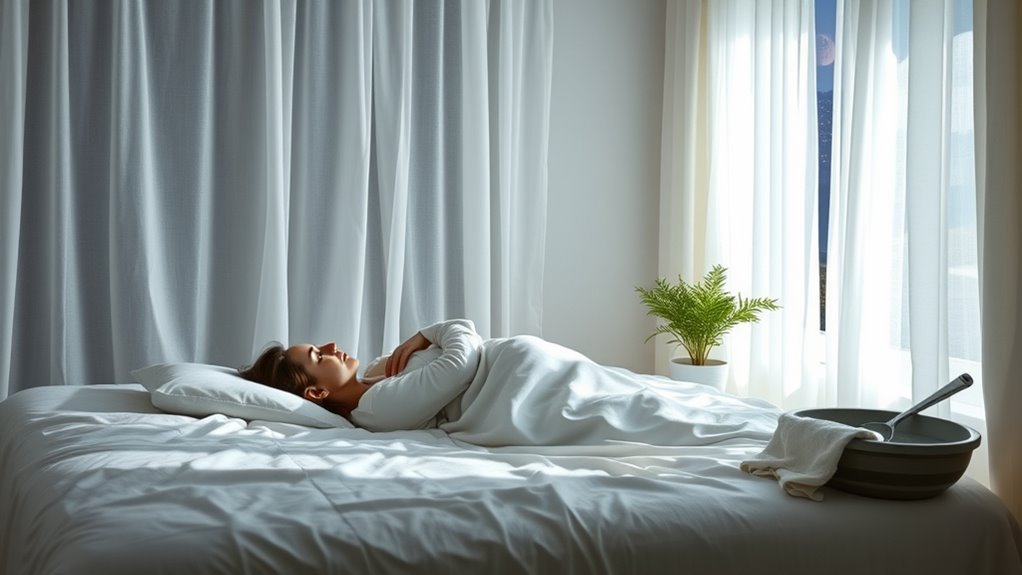
Natural methods can effectively help you lower your body temperature and stay cooler on hot days. One key approach is practicing hydration strategies, which support your body’s natural temperature regulation. Drinking cold water throughout the day helps cool your core and prevents dehydration, which can impair your body’s ability to regulate heat. You can also take cool showers or splash cold water on your wrists and neck, where blood vessels are close to the surface, to promote rapid cooling. Wearing loose, breathable clothing made from natural fibers allows heat to escape more easily. Additionally, staying in shaded or breezy areas during the hottest parts of the day helps maintain a lower body temperature. These simple, natural techniques work together to keep you feeling cooler and more comfortable.
Smart Ways to Keep Your Home Cool Without Excess Energy Use

By implementing smart strategies, you can keep your home cooler without racking up high energy bills. Focus on energy efficient cooling and eco friendly ventilation to maximize comfort while minimizing energy use. Open windows during cooler parts of the day, creating cross-ventilation that naturally cools your space. Use ceiling fans to circulate air efficiently, reducing the need for air conditioning. Install window shades or reflective films to block out heat from the sun. Incorporate indoor plants to improve airflow and humidity levels. These simple steps promote eco friendly ventilation and help your home stay cool without excess energy consumption, making summer nights more comfortable and sustainable.
Hydration Tips to Help Your Body Stay Comfortable Through the Night

Staying well-hydrated is essential for keeping your body cool and comfortable throughout the night, especially during hot summer months. Effective hydration strategies involve drinking water consistently throughout the day and having a glass nearby before bed. To maintain electrolyte balance, consider consuming beverages with electrolytes, like sports drinks or coconut water, but avoid excess sugar. Proper hydration helps regulate your body temperature and prevents dehydration, which can cause discomfort and disturbed sleep. Keep in mind that overhydration can lead to frequent bathroom trips, so sip fluids steadily. By prioritizing hydration and maintaining electrolyte levels, you support your body’s natural cooling processes, helping you stay comfortable and restful all night long.
Incorporate Cooling Devices and Tech Into Your Sleep Routine

Using cooling devices and technology can considerably enhance your efforts to stay comfortable during hot summer nights. Smart cooling systems, like programmable fans or climate-controlled beds, allow seamless tech integration, making your sleep environment cooler and more consistent. You might imagine:
- A sleek, app-controlled fan that adjusts airflow with a tap
- A mattress with built-in cooling gel layers
- A smart thermostat that maintains ideal bedroom temperatures
- Bedside devices that monitor and optimize sleep conditions
These tools help automate temperature regulation and create a more restful atmosphere. By incorporating smart cooling and tech integration into your routine, you reduce heat buildup and avoid disruptive sweating, ensuring a cooler, more comfortable sleep throughout the night.
Adjust Your Evening Activities to Promote Better Sleep Conditions
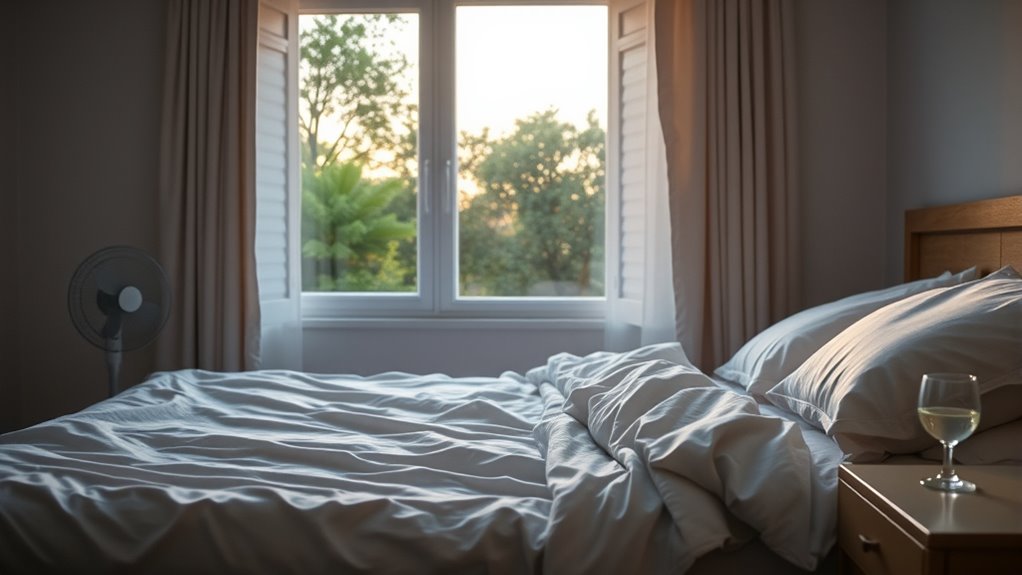
Adjusting your evening activities can markedly improve your sleep environment during hot summer nights. Start by incorporating calming activities like evening meditation to lower stress and cool your mind before bed. This helps reduce body tension and promotes a more restful sleep. Additionally, aromatherapy relaxation with soothing scents such as lavender or chamomile can create a cool, calming atmosphere in your bedroom. Diffuse essential oils or use a scented pillow spray to enhance comfort. Avoid stimulating activities like vigorous exercise or screen time close to bedtime, as they can raise your body temperature. Instead, focus on relaxing routines that signal your body it’s time to wind down. These simple changes can help you fall asleep faster and stay cooler throughout the night.
Establish a Summer Sleep Routine for Consistent Comfort

Creating a consistent summer sleep routine helps your body recognize when it’s time to wind down, making it easier to fall asleep and stay cool throughout the night. Establishing regular bedtime rituals signals to your body that rest is coming, promoting better sleep and comfort. Focus on creating a calming sleep environment by dimming the lights, lowering the thermostat, and removing distractions. Consistency in your schedule trains your internal clock, reducing sleep disruptions. Incorporate relaxing activities like gentle stretching, reading, or listening to soothing music as part of your routine. Keep your sleep environment cool and comfortable, ensuring your body associates bedtime with a revitalizing, restful space. Over time, this routine helps your body adapt, leading to more restful, cooler summer nights.
Frequently Asked Questions
How Can I Prevent My Pillow From Trapping Heat Overnight?
To prevent your pillow from trapping heat overnight, choose pillows made from cooling materials like gel-infused memory foam or breathable latex. Add a cooling pillowcase made of moisture-wicking fabrics such as cotton or bamboo, which help dissipate heat. Avoid heavy or non-breathable covers, and consider using a fan or air conditioner to enhance airflow. These steps keep your pillow cool, making your sleep more comfortable and revitalizing.
Are There Specific Foods That Help Cool My Body Before Sleep?
Yes, you can eat hydrating fruits like watermelon, cucumber, and oranges to help cool your body before sleep. Also, drinking cold drinks or herbal teas can lower your core temperature and keep you refreshed. Avoid heavy, spicy foods that raise your body heat. Incorporate these cooling foods into your evening routine to promote a more comfortable, restful sleep during hot summer nights.
Can Certain Sleep Positions Improve Heat Dissipation?
Choosing an open sleep posture, like sleeping on your side with knees slightly bent, can improve heat dissipation by promoting better airflow around your body. For example, a person who switched to this position reported feeling cooler and more comfortable overnight. Your body temperature drops more efficiently when your sleep posture allows air to circulate, helping you stay cooler during hot summer nights. Experiment with different positions to find what cools you best.
How Does Humidity Affect My Ability to Stay Cool at Night?
Humidity makes it harder for your body to cool down because moisture stays on your skin, trapping heat. To stay cool, guarantee good air circulation in your bedroom and focus on moisture control by using a dehumidifier or fans. These steps help reduce humidity levels, allowing sweat to evaporate more efficiently and keeping you comfortable throughout the night, so you can sleep cooler even on muggy summer nights.
What Are Signs of Heat Exhaustion During Sleep?
If you notice night sweats or restless sleep, you might be experiencing heat exhaustion. Other signs include feeling dizzy, nausea, headache, or weakness. Your skin may feel clammy or cool to touch, and your pulse could be rapid. If these symptoms occur, it’s important to cool down quickly, hydrate, and rest. Ignoring these signs can lead to more serious heat-related illnesses, so stay vigilant during hot nights.
Conclusion
Staying cool in summer isn’t just about luck—it’s about smart choices and understanding your body’s natural responses. While some believe that sleeping in a cooler room directly improves sleep quality, studies suggest that maintaining a consistent, comfortable temperature helps regulate your circadian rhythm. By combining practical tips with a little scientific insight, you can create a restful summer sleep environment. Embrace these strategies, and you’ll find that staying cool isn’t just a myth—it’s achievable.
